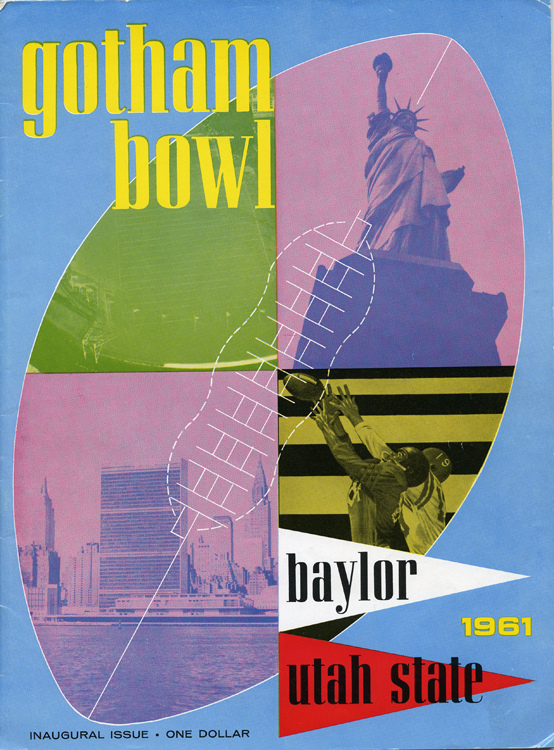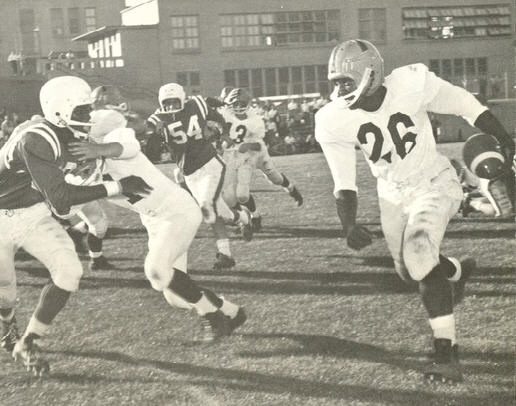

ONE OF THE REALLY GOOD ONES, MACARTHUR "MAC TRUCK" LANE
HELMET HUT NEWS/REFLECTIONS December 2015:
ONE OF THE REALLY GOOD ONES,
MACARTHUR "MAC TRUCK" LANE
By Dr. Ken
I have often said that for a
street smart teenager, I knew
little about the world outside
of the New York City area. The
Sunday New York Times football
scores and game write-ups were
my window to the rest of the
United States, augmented by the
few collegiate or professional
games that were televised on our
small black and white DuMont
set. My horizons expanded a bit
upon entering college and
meeting players from Ohio,
Pennsylvania, Indiana, and
Kentucky but anything west of
Illinois could have been on the
other side of the earth.
Certainly, the only information
I had regarding college football
in the western U.S. other than
the major West Coast schools,
came from Street And Smith
Football Magazine or Sports
Illustrated. Utah was one of the
states that I had obviously
viewed on a map but in truth, I
couldn’t be certain of its exact
location. I knew something of
the college programs out there
because of the success of Lee
Grosscup [ see HELMET NEWS Nov.
2013
http://www.helmethut.com/Features/Dr.Ken121.html
and Dec. 2013
http://www.helmethut.com/Features/Dr.Ken122.html
] Merlin Olsen, and the team
that played in the 1961 Gotham
Bowl. Utah State was one of the
participants in that bowl game
played at what was then a
run-down and rat infested Polo
Grounds in the Bronx. Having
attended a number of New York
Titans games at that same venue,
I knew tickets would be
available at the gate and wanted
to see the undefeated, once-tied
Utah State team with Olsen and a
number of future NFL players
that included Lionel Aldridge,
Bill Munson, Clark Miller, Jim
Turner, and Clyde Brock. Return
man extraordinare and ’60 All
American Tom Larsheid was often
featured on newsreels at the
local movie theater and was a
key man on their attack. Despite
a trip that entailed a train
ride and two subway transfers, I
enjoyed the game that was played
against Baylor, featuring Don
Trull and Ronnie Bull. The
talented USU Aggies were
impressive despite losing and I
filed away the information that
there was excellent football in
what was to me an isolated part
of the United States.
 |
One of the fellows that played at a local high school had a cousin from upstate New York that was a member of the University Of Hawaii football squad. A girl I knew from the beach had decided to attend the school, but it was so far away and so exotic, that the possibility of knowing anyone who actually played there was beyond remote until our group met this fellow. Joining us for some of our summer training sessions, we were surprised that at only 190 pounds, he was one of their linemen, immediately marking him as a “tough guy” and we let him know that we were impressed. He in turn told us about a linebacker that he believed was the “toughest and strongest player in the country,” a Utah State Aggie that most opponents were actually afraid of. He was clear that while he won a letter, he was not a starter on the Hawaii squad and watching film prior to facing off against Utah State, “that was okay because (he) wanted no part of this guy.” The linebacker I would come to learn was MacArthur Lane.
The brief encounter and
conversation that mentioned
Lane sent me to my
collection of football
magazines and as the 1966
and ’67 seasons unfolded, it
became obvious that Lane,
now an All American
candidate at running back,
was that same frightening
linebacker who had been
vital to the 8-2 USU record
in ’65. Hardly typical,
MacArthur Lane came to his
toughness through his
Oakland upbringing, playing
as an All City performer at
Fremont High School, and a
post-high school journey
that took him from labor in
a machine shop to the United
States Marine Corps.
 |
A big time running back at Oakland’s Fremont High School, Lane chose manual labor and the Marine Corps before enrolling at local Merritt Junior College where he was a JC All American in 1964
After his discharge and wanting to re-start his football career, Lane entered Merritt Junior College playing the unlikely combination of quarterback and guard but settled in to the linebacker and running back positions where he was a 1964 Junior College All American and eventual selection to the California Junior College Hall Of Fame. Choosing Utah State as a landing spot for the continuation of his college career was not so strange, not with the line-up that had represented the team in ’61 and not with a current roster that included Lane’s junior college backfield mate Roy Shivers and line stand-outs Bill Staley and Spain Musgrove. With Utah State relying on their recruitment of California high school and junior college players, Lane joined a number of JC players he had competed against. Less known as a player but a fierce competitor who was a full time starter, linebacker/middle guard Al Vermeil of Calistoga, California had been coached by his older brother Dick and later became known as one of the pioneers in the strength training field for athletes. With All American Staley, Musgrove, Vermeil, and right outside linebacker Lane, the Aggies were quite formidable and completed an 8-2 record in ‘65.
The Ags fell off to
4-6 in 1966, in part
due to injuries
which scuttled their
passing attack. Lane
too was injured
after being moved to
running back but his
late season rushing
for 558 yards was
highlighted by a 7.6
yard per carry
average and four
touchdowns. Head
coach Tony Knap, who
had been an
exceptionally
successful high
school coach before
developing John
Ralston’s lines at
Utah State, took the
head position when
Ralston left for
Stanford prior to
the ’63 season. His
four year run
included two 8-2
seasons but he had
some detractors in
the school’s
administration and
his decision to kick
a field goal while
down 21-0 to arch
rival BYU and then
punting on fourth
down late in the
game instead of
trying to better the
existing 27-7 score,
had some fans turn
against him. Thus,
at the conclusion of
the ’66 season, Knap
left for the CFL and
later returned to
become head coach at
both Boise State and
UNLV, completing his
college head
coaching career with
an excellent .725
winning percentage.
New USU head coach
Chuck Mills was
hired from the
Kansas City Chiefs
staff and looking at
a backfield of 6’1”,
220 pound Mac
“Truck” Lane, future
Detroit Lions back
Altie Taylor, and
stout Frank Nunn,
installed a Power-I
offense.
Lane was an early
advocate of strength
training and
physical
conditioning

The 1967 record
improved to 7-2-1
with Lane injured in
the season’s sixth
game, yet he had 207
yards against West
Texas State,
completed the season
with a 6.4 yards per
carry, and was
chosen to play in
the Chicago College
All Star Game. Lane
participated on the
Aggie track and
field team during
his college stay,
mimicking the Billy
Cannon combination
of sprinting and
throwing the shot
put, marking a throw
that was only two
inches short of
Olympian Jay
Silvester’s school
record. Always a
hard worker and one
who pursued the
extremes of physical
conditioning, Lane
was drafted number
thirteen overall by
the St. Louis
Cardinals in 1968.
He was underutilized
his first two
seasons in a crowded
backfield that
included Johnny
Roland, Willis
Crenshaw, Cid
Edwards, and juco
and college teammate
Roy Shivers, but hit
his stride in an All
Pro performance in
1970, rushing for
977 yards and adding
another 365 on
receptions with an
NFL high thirteen
total touchdowns. As
usual, he was
considered to be one
of the toughest
athletes in the NFL
and maintained a
very high level of
fitness and rigorous
training.